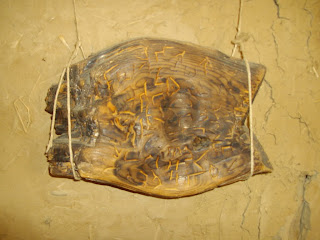Embrioni di dinosauri trovati in Cina. Studio pubblicato su Nature il 10 Aprile 2013.
 |
| Embrione di sauropodomorfi |
Il ritrovamento indica che la crescita in fase embrionale era rapidissima e che i dinosauri erano in grado di flettere i muscoli ancora dentro l'uovo.
Lo studio, pubblicato su Nature l'11 Aprile 2013, ha coinvolto un gruppo di ricerca internazionale, coordinato dal paleontologo Robert Reisz (Università di Toronto Mississauga), che ha scavato e analizzato più di 200 ossa di 20 individui embrionali a diversi stadi di crescita.
Andrea Mameli www.linguaggiomacchina.it 11 Aprile 2013
Embryology of Early Jurassic dinosaur from China with evidence of preserved organic remainsNature 496, 210–214
doi:10.1038/nature11978
Robert R. Reisz, Timothy D. Huang, Eric M. Roberts, ShinRung Peng, Corwin Sullivan, Koen Stein, Aaron R. H. LeBlanc, DarBin Shieh, RongSeng Chang, ChengCheng Chiang, Chuanwei Yang, Shiming Zhong
Abstract
Fossil dinosaur
embryos are surprisingly rare, being almost entirely restricted to
Upper Cretaceous strata that record the late stages of non-avian
dinosaur evolution. Notable exceptions are the oldest known embryos from the Early Jurassic South African sauropodomorph Massospondylus and Late Jurassic embryos of a theropod from Portugal.
The fact that dinosaur embryos are rare and typically enclosed in
eggshells limits their availability for tissue and cellular level
investigations of development. Consequently, little is known about
growth patterns in dinosaur embryos, even though post-hatching ontogeny
has been studied in several taxa.
Here we report the discovery of an embryonic dinosaur bone bed from the
Lower Jurassic of China, the oldest such occurrence in the fossil
record. The embryos are similar in geological age to those of Massospondylus and are also assignable to a sauropodomorph dinosaur, probably Lufengosaurus.
The preservation of numerous disarticulated skeletal elements and
eggshells in this monotaxic bone bed, representing different stages of
incubation and therefore derived from different nests, provides
opportunities for new investigations of dinosaur embryology in a clade
noted for gigantism. For example, comparisons among embryonic femora of
different sizes and developmental stages reveal a consistently rapid
rate of growth throughout development, possibly indicating that short
incubation times were characteristic of sauropodomorphs. In addition,
asymmetric radial growth of the femoral shaft and rapid expansion of the
fourth trochanter suggest that embryonic muscle activation played an
important role in the pre-hatching ontogeny of these dinosaurs. This
discovery also provides the oldest evidence of in situ preservation of complex organic remains in a terrestrial vertebrate.



Commenti